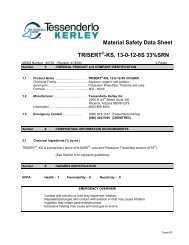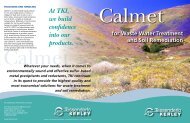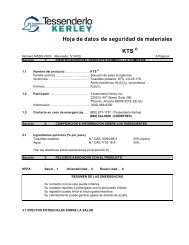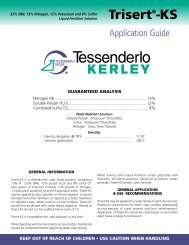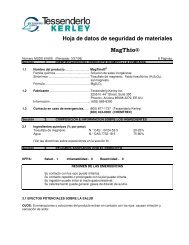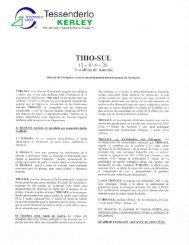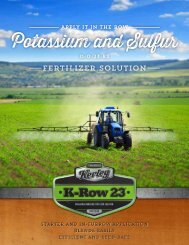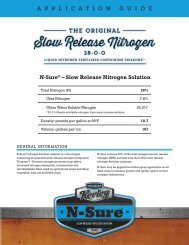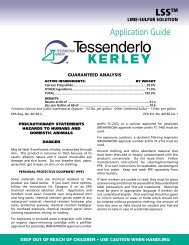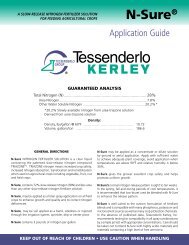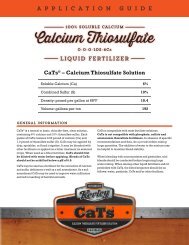Captor_TechSheet - Tessenderlo Kerley
Captor_TechSheet - Tessenderlo Kerley
Captor_TechSheet - Tessenderlo Kerley
You also want an ePaper? Increase the reach of your titles
YUMPU automatically turns print PDFs into web optimized ePapers that Google loves.
<strong>Captor</strong> ®<br />
Calcium Thiosulfate Solution<br />
Many treatment plants today are looking to use inherently safer chemicals to reduce hazards to health and the environment.<br />
One of these chemicals is <strong>Captor</strong>, which has become an attractive alternative to traditional water treatment chemicals used for<br />
dechlorination and ozone quenching.<br />
<strong>Captor</strong> is now solving a number of traditional problems for water and wastewater treatment plant operators. Tank and line<br />
heating are generally not needed, and the product presents no problem with off-gassing. <strong>Captor</strong> offers several advantages over<br />
the use of traditional treatment chemicals, including:<br />
• It is a non-hazardous solution<br />
• Maintains a low freezing point<br />
• No potential SO2 exposure<br />
• pH Neutral<br />
• Nearly Odorless<br />
• Water Clear<br />
In addition, the use of <strong>Captor</strong> places less stress on the environment as compared to other chemicals. <strong>Captor</strong> is not an oxygen<br />
scavenger and consequently does not reduce dissolved oxygen; its near-neutral pH hardly affects the pH value of the water.<br />
TYPICAL PROPERTIES<br />
Active Ingredient [w/v % Calcium Thiosulfate]................................................30% Minimum<br />
Active Ingredient [w/w % Calcium Thiosulfate] ..............................................24% Minimum<br />
pH [Full Strength] .............................................................................................6.5-8.0<br />
Specific Gravity.................................................................................................1.20-1.32<br />
Weight per US Gallon........................................................................................10-11 lbs/gal<br />
Crystallization Temperature..............................................................................24-28°F (-4.4 to -2.2°C)<br />
PACKAGING AND HANDLING<br />
<strong>Captor</strong> is manufactured as an aqueous solution according to NSF Standard 60 at several sites here in the US. It is available in nonreturnable<br />
drums or totes, or shipped in bulk tank trucks or cars. Store totes, drums and small containers out of direct sunlight at moderate<br />
temperatures. Materials of construction suitable for storing and handling <strong>Captor</strong> include stainless steel, aluminum, fiberglass, poly tanks<br />
or lined carbon steel.<br />
<strong>Captor</strong> is considered non-hazardous with NFPA ratings: 0–0–0 for health, flammability, and reactivity. The vapor space over the solution<br />
is largely water (no off-gassing) and bulk storage is generally permitted without secondary containment. Avoid mixing <strong>Captor</strong> with acids.<br />
Observe all safety precautions shown on the Material Safety Data Sheet.<br />
(For dosage rates see back page)<br />
The information contained herein is based on data which is believed to be accurate.<br />
However, no warranty of merchantability, fitness for use, or any other warranty is<br />
expressed or is to be implied concerning the accuracy of these data, the results to be<br />
obtained from the use of the material, or the hazards connected with such use. This<br />
information is furnished on the condition that the person receiving it shall make his<br />
own determination as to the suitability of the material for his particular purpose<br />
and on the condition that he assumes the risk for his use thereof.<br />
<strong>Tessenderlo</strong> <strong>Kerley</strong>, Inc<br />
2255 N. 44th Street<br />
Suite 300<br />
Phoenix, AZ 85008<br />
Telephone 602.889.8300<br />
Toll Free 800.525.2803<br />
www.tkinet.com
Dosage Rates for Dechlorination<br />
Gallons of <strong>Captor</strong> Per Million Gallons of Water<br />
Parts per Million Chlorine<br />
pH 1 2 3 4 5 6 7 8 9 10<br />
6.5 5.4 10.9 16.3 21.7 27.1 32.5 37.9 43.4 48.8 54.2<br />
6.8 5.3 10.5 15.8 21.0 26.3 31.5 36.8 42.0 47.1 52.5<br />
7.0 5.1 10.3 15.4 20.6 25.7 30.8 36.0 41.1 46.2 51.4<br />
7.2 5.0 10.0 15.1 20.1 25.1 30.1 35.2 40.2 45.2 50.2<br />
7.4 4.9 9.8 14.7 19.6 24.5 29.4 34.3 39.2 44.2 49.1<br />
7.6 4.8 9.6 14.4 19.2 24.0 28.7 33.5 38.3 43.1 47.9<br />
7.8 4.7 9.3 14.0 18.7 23.4 28.0 32.7 37.4 42.1 46.7<br />
8.0 4.6 9.1 13.7 18.2 22.8 27.3 31.9 36.5 41.0 45.6<br />
8.5 4.3 8.4 12.8 17.1 21.3 25.6 29.9 34.1 38.4 42.7<br />
9.0 4.0 8.0 11.9 15.9 19.9 23.9 27.8 31.8 35.8 39.8<br />
9.5 3.7 7.4 11.1 14.8 18.4 22.1 25.8 29.5 33.2 36.9<br />
10.0 3.4 6.8 10.2 13.6 17.0 20.4 23.8 27.2 30.6 34.0<br />
Dosage Rates for Ozone Quenching<br />
Gallons Per Minute (GPM) of <strong>Captor</strong> to Use<br />
Treated Water<br />
Ozone Residual – ppm<br />
Flow In GPM 0.1 0.2 0.3 0.4 0.5 0.6 0.7 0.8 0.9 1.0<br />
100,000 0.03 0.05 0.08 0.11 0.13 0.16 0.19 0.21 0.24 0.26<br />
200,000 0.05 0.11 0.16 0.21 0.26 0.32 0.37 0.42 0.48 0.53<br />
300,000 0.08 0.16 0.24 0.32 0.40 0.48 0.56 0.64 0.71 0.79<br />
500,000 0.13 0.26 0.40 0.53 0.66 0.79 0.93 1.06 1.19 1.32<br />
1,000,000 0.26 0.53 0.79 1.06 1.32 1.59 1.85 2.12 2.38 2.65<br />
These rates are approximate and may be affected by factors such as temperature, reaction time<br />
and dissolved compounds in water which may react with <strong>Captor</strong>.



